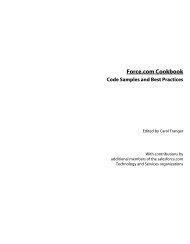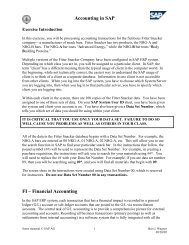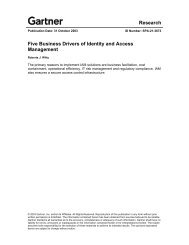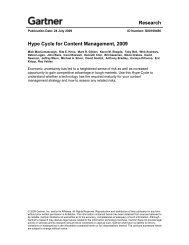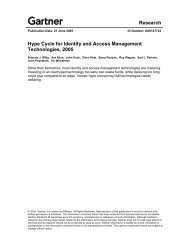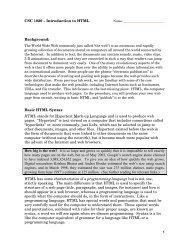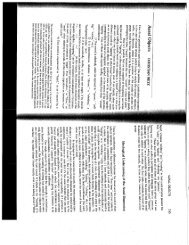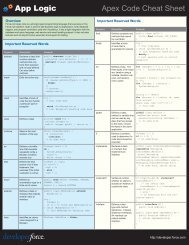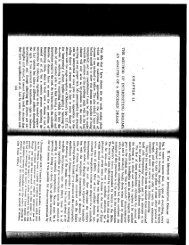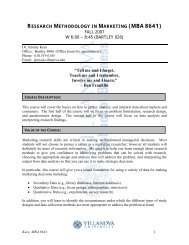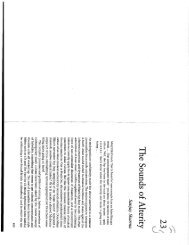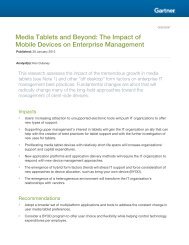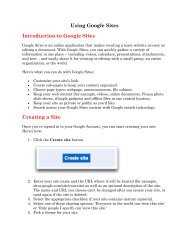Content Management Framework
Content Management Framework
Content Management Framework
You also want an ePaper? Increase the reach of your titles
YUMPU automatically turns print PDFs into web optimized ePapers that Google loves.
<strong>Framework</strong> • 11<br />
document by Microsoft Word), as well as “date<br />
modified,” “type,” and “size” (attributes provided<br />
by an underlying filing system).<br />
• Some metadata are based on an information taxonomy<br />
that encompasses a conceptual hierarchy<br />
or thesaurus. As a result, some terms may be<br />
synonyms of other terms—“HP” and “Hewlett-<br />
Packard” describe the same company. Some<br />
terms may be more specific or more general descriptions<br />
of other terms—“Ford Taurus,” for<br />
example, is a particular kind of “automobile.”<br />
• Some metadata encompass an underlying information<br />
schema in which the terms are related<br />
based on predefined rules. For instance, “California”<br />
and “Wisconsin” are part of a schema<br />
that identifies the fifty states in the United<br />
States.<br />
TAXONOMY AND SCHEMA MANAGEMENT CA-<br />
PABILITIES. A content management system should<br />
include capabilities for managing the underlying<br />
taxonomies and schemas. It should include features<br />
and functions so that catalogers, librarians, and other<br />
information architects can manage the structured<br />
lists of terms that constitute a taxonomy or schema.<br />
AUTOMATIC CATEGORIZATION CAPABILI-<br />
TIES. A content management system should offer<br />
automated or semi-automated tagging and content<br />
categorization capabilities, based on analyzing<br />
words and phrases. It should either enable authors<br />
and editors to select from a dynamically generated<br />
list of relevant terms or automatically make the selection<br />
for them.<br />
APPLICATION INTEGRATION<br />
An Enterprise Perspective<br />
Managing content throughout an enterprise is becoming<br />
a core competency for the organization as a<br />
whole. As companies launch their CRM initiatives,<br />
benefit from their ERP installations, plan their<br />
ecommerce strategies, and design other enterprise<br />
applications, they need to create and distribute relevant<br />
content.<br />
As companies deploy content management systems,<br />
they need to be able to integrate the content<br />
they are managing with their enterprise applications.<br />
Application integration capabilities provide the connections<br />
and interfaces for incorporating the capabilities<br />
of a content management system with those<br />
of other enterprise systems.<br />
Key Factors<br />
The three kinds of application integration capabilities<br />
to consider are:<br />
• APIs and toolkits<br />
• Application-level frameworks<br />
• Packaged integration connectors<br />
APIs AND TOOLKITS. APIs and toolkits provide<br />
the programming-level interfaces that system-level<br />
programmers use to connect content management<br />
systems with enterprise applications. APIs and toolkits<br />
provide tight integration between two systems<br />
but require low-level and complex application design<br />
and development activities.<br />
APPLICATION-LEVEL FRAMEWORKS. Application-level<br />
frameworks describe the prebuilt business<br />
objects that are used by application developers to<br />
connect the actions of one system with those of another.<br />
These frameworks provide higher-level structures<br />
and tools, including collections of prebuilt<br />
components, and thus accelerate integration.<br />
PACKAGED INTEGRATION CONNECTORS.<br />
Packaged integration connectors provide prebuilt<br />
capabilities to integrate with portals and other thirdparty<br />
enterprise applications. These connectors accelerate<br />
application integration by defining the information<br />
flows between a content management system<br />
and external applications.<br />
ADMINISTRATION<br />
Centralized Systems <strong>Management</strong><br />
A content management system should be an integral<br />
part of an enterprise-wide systems management<br />
framework; the administration of the content management<br />
system should fit into that management<br />
framework.<br />
© 2004 Patricia Seybold Group • Unauthorized redistribution of this report is a violation of copyright law. A Customers.com ® Research Service



